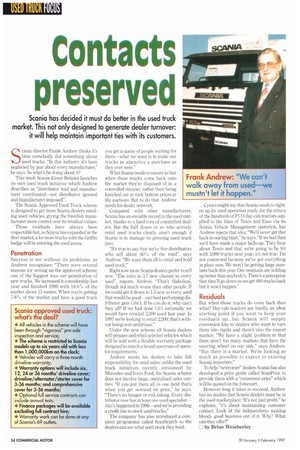Contacts preserved
Page 36

If you've noticed an error in this article please click here to report it so we can fix it.
Scania director Frank Andrew thinks it's time somebody did something about used trucks. "In this industry it's been neglected by just about every manufacturer," he says. So what's he doing about it?
This week Scania (Great Britain) launches its own used truck initiative which Andrew describes as "distributor lead and manufacturer coordinated—not distributor ignored and manufacturer imposed!".
The Scania Approved Used Truck scheme is designed to get more Scania dealers retailing used vehicles, giving the Swedish manufacturer more control over its residual values.
Those residuals have always been respectable but, as Scania has expanded in the fleet market, a lot more trucks with the Griffin badge will be entering the used arena.
Penetration
Success is not without its problems, as Andrew recognises: "There were several reasons for setting up the approved scheme; one of the biggest was our penetration of new trucks. We increased it considerably last year and finished 1996 with 18.6 '-..ii of the market above 15 tonnes. When you're getting 7-8".0 of the market and have a good truck you get a queue of people waiting for them—what we want is to make our trucks as attractive a purchase as they ever were."
What Scania needs to ensure is that when those trucks come back onto the market they're disposed of in a controlled manner, rather than being knocked out at rock bottom prices at the auctions. But to do that Andrew needs his dealer network.
Compared with other manufacturers, Scania has an enviable record in the used market, thanks to a hard core of committed dealers. But the half dozen or so who actively retail used trucks clearly aren't enough if Scania is to manage its growing used truck pare.
"It's true to say that we've five distributors who sell about 60% of the total", says Andrew. "We want them all to retail and hold used stock."
Right now more Scania dealers prefer to sell new. "The ratio is 3.7 new chassis to every used", reports Andrew. "That's diabolical, though not much worse than other people. If we could get it down to 1.5 new to every used that would be good—our best performing distributor gets 1.64:1. If he can do it, why can't they all? If we had done 1.6:1 nationally we would have retailed 3,200 used last year. In 1997 we're looking to retail 2,200; that's without being over ambitious."
Under the new scheme all Scania dealers will prepare and retail selected vehicles which will be sold with a flexible warranty package designed to match a broad spectrum of operator requirements.
Andrew wants his dealers to take full responsibility for used sales: unlike the used truck initiatives recently announced by Mercedes and Iveco Ford, the Scania scheme does not involve large, centralised sales centres: "If you put them all in one field that's when you get screwed on price," he says. "There's no hunger or risk taking. Every distributor now has at least one used specialist— that's happened in 1996—and we're providing a credit line to stock used trucks."
The company has also introduced a computer programme called ScanSearch So the dealers can see what used stock they hold. Cynics might say that Scania needs to tight en up its used operation ready for the return of the hundreds of P113 day-cab tractors supplied to the likes of Tesco and Esso via its Scania Vehicle Management operation, but Andrew rejects that idea: "We'll never get that back in one big blast," he says. "If we had then we'd have made a major balls-up. They hear about Tesco and that we're going to be hit with 3,000 trucks next year; it's not true. I'm not concerned because we've got everything in place now. We won't be getting large numbers back this year. Our residuals are holding up better than anybody's. There's a perception that they'll go down as we get 400 trucks back but it won't happen."
Residuals
But when those trucks do come back then what? Day-cab tractors are hardly an ideal starting point if you want to keep your residuals up, but Scania will supply conversion kits to dealers who want to turn them into rigids and there's also the export market. "We have a slight problem in that there aren't too many markets that have the steering wheel on our side," says Andrew. "But there is a market. We're looking as much as possible to export to existing Scania importers."
To help "newcomer" dealers Sarnia has also developed a price guide called ScanPrice to provide them with a "consensus price" which will be quoted on the forecourt.
However long it takes to succeed, Andrew has no doubts that Scania dealers must be in the used marketplace: "It's not just profit," he explains, "it's about maintaining customer contact. Look at the independents making bloody good business out of it Why? What can they offer?"
Li by Brian Weatherley








































































































